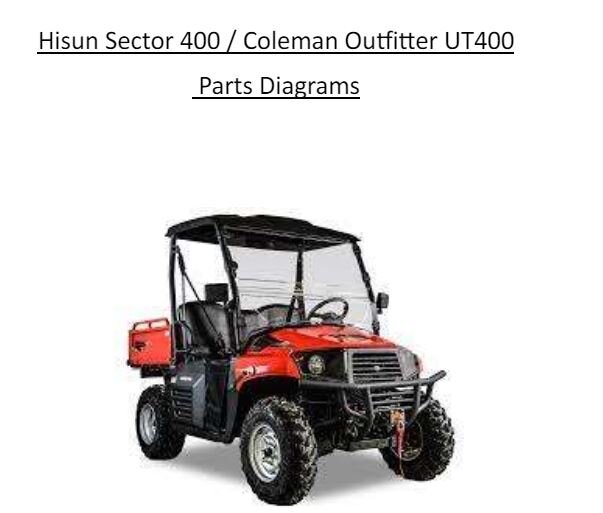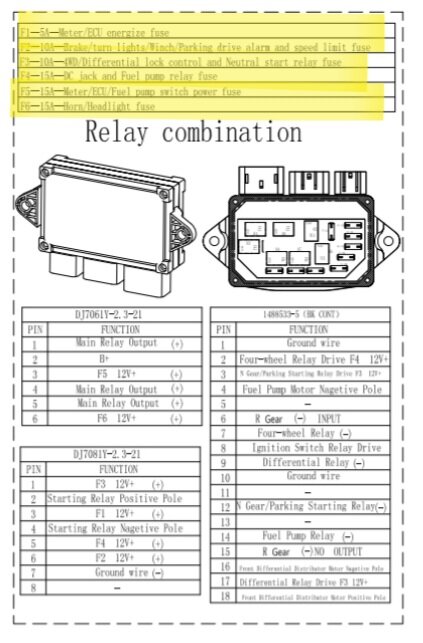-
Posts
288 -
Joined
-
Last visited
-
Days Won
44
Content Type
Profiles
Events
Forums
Gallery
Downloads
Community Map
Posts posted by aefron88
-
-
Being that yours was unassembled and we've gone through the troubleshooting stuff it might be worth double checking everything is properly connected wire wise, and we didn't miss something stupid. I've never heard of an ECU failing on a brand new unit (not saying it isnt possible)
Just to confirm you have all the plugs in the bottom of the ECU & Fuse boxes properly plugged in, give them a push and make sure sometimes they don't get pushed in all the way and aren't connecting. Same with all the various sensor plugs on the engine, and the crank position sensor plug on the right side of the engine case.
You said it cranks properly, when you turn the key to on does the dash display come on? Is there someone else that could listen for the fuel pump with the seat out its fairly obvious if you're in a quiet area?
-
10 hours ago, hdtran said:
Hello,
The engine lubrication oil is not the same as the transmission/differential oil. The engine oil does "bathe" the clutch.
When you change the oil, there are different intervals for the engine and for the transmission/differential case. The oil types are also different for the engine and the differential case.
Best regards.
That's sort of a confusing answer because of the way hisun terminology works.
The engine & the wet clutch & the high/low/reverse gears (which is what we traditionally term a "transmission") all share oil.
The rear differential has its own oil, but it isn't a "transmission" except in hisuns terminology. They also use the term "final drive" or something like that in some literature.
-
 2
2
-
-
If it's jumping timing likely the chain is stretched. Usually thats more a a function of wear on the pins from poor oil lubrication. Excessive metal in the oil, etc. It could just be poor metalurgy/manufacturing on the chain too.
The hisun equivalent uses the same chain as the Yamaha Rhino 660. They actually even accidentally use the Yamaha P/N in the service manual. There are a ton of these available sub $20 on amazon/ebay etc. Any chance that the motor uses the same chain? Can you send a pic and count the links? I'm assuming the motor may also be a Yamaha knockoff like Hisun.
Also you'll probably have more luck in the model specific forum.
-
I don't know anything about the atvs, but he you tried shorting the solenoid with a screwdriver, and if so does it crank over or start?
-
Gotcha, well keep us updated when the new coil shows up
-
Ok next up step is #6 on the instruction pictures I posted above: Checking the ignition coil. The ignition coil you can find by following the spark plug lead. Test primnary and secondary as directed in the picture above step #6.
As far as step 8: Contrary to the manual I don't believe there's a magneto coil on these EFI units, the ignition coil is driven directly by the ECU. This step should be something like "verify crankshaft position sensor" but thats going to require an oscilloscope or HUD Ecu hacker & Cables & a PC. You can at least verify that the sensor is plugged in correctly. Plug is the wires coming out of the passenger side of the crankcase. Should be a 4 pin square plug (IE 2x2)
Let me know what you find and we can continue from there
-
F1 fuse is a 5 amp and controls the ECU/dash display which would mean no spark. Dies it start (or at least have spark) with the f1 fuse replaced?
-
sorry for the delay on this, I assume you have figured it out by now but for anyone that comes along later:
Yes, the Coleman UT400 is the same as the Hisun HS400. Same for the various other sizes, all Coleman UTVs are rebadged models made by Hisun. The service manuals leave a lot to be desired, and leave out some important steps, but if you have some mechanical experience you should be able to figure out the missing parts.
-
No worries, i'm not sitting around waiting. I just enjoy solving mechanical puzzles.
F4 should be a 15 amp fuse and runs the fuel pump relay & dc jack. Without that you wont get fuel to start the engine. Replace that and see what happens.
When you turn the key to on (not start) you should hear the fuel pump kick on (slight hum under the passenger seat) for about 5 seconds before it builds pressure.
The little black boxes are relays, shouldnt need to touch those, and i'm not aware of any replacements aside from getting a new fuse box ($80ish bucks)
-
There's no brake switch. The shift lever just operates a lever on the engine case, purely mechanical.
-
 1
1
-
-
The needle adapter shown in the first post makes it so you don't need to be straight perpendicular like with a traditional grease gun coupler, You need to make sure you're buying the blunt type like that, there are also sharp needles meant for piercing rubber in ball joints, etc.
With the blunt needle adapter you basically shove it into the check ball. It does make a bit more of a mess than a normal coupler, but it does fit. The driveshaft zerks are certainly have limited clearance.
The other option is a small grease gun that just fits on top of the zerk without coupling. You can see one pictured in the "rear driveshaft" pic Something like this
-
 1
1
-
-
Ok so lets start off simple on the instructions I posted above. I'm assuming you have a Volt/Ohm meter, if not you'll need to get one. If you find something wrong in any of these steps rectify, and then try starting again.
Just so we're clear, how are you checking for spark and determining that you don't have one? Are you sure you have the key wired up correctly to the proper terminals?
-First check all the fuses. There is a fuse on the positive battery cable. The remaining fuses are inside the box forward of the battery under the seat. Remove the cover (4 Philips screws) and check each fuse for continuity.
-If those are all good, next step is check the battery. Should have 12.5V or more. If it doesn't charge it.
-Next step is to inspect the plug, make sure it is clean, not fouled, and gapped properly. If it's still in new condition, and not soaked in gas it's likely OK.
Let me know the answers to above, and confirm all those steps are complete with no resolution.
-
likely running extremely rich, Best guess would be failed O2 sensor, but thats just a guess. I believe those models are likely carbed vs fuel injected, so let me know if thats incorrect.
Likely your carberateur jet setting is wrong, or the choke is stuck on. Have you ever cleaned it? Could you post a pic or model info of the carb I'm not sure what type the older models even have?
-
On 2/24/2024 at 9:17 PM, Hi sun 500 said:
hello everyone, i just joined this forum to try my luck, few days ago i bought an old (dont know exactly), 2011/14 hi sun 500cc ""carburated"", was not running at the time, but i fell was a good deal and decided it to bring it home to play with it, this is the issue, i bought and installed a new carb, and pump, i repositioned the battery location and upgraded to a "car batt", reconnected the fuel lines and started it, but it only runs with the choke ON, i checked the bowl, it does have fuel,but for some reason wont inject it to run, i came across a video that say that ""the body small tank had to be connected for the cart to run" (was deleted when bought), sure enough i got it to run sporadically , but the so called ""small body tank'' often runs out of fuel and wont refill itself , i had to couple times do it manually, so how does that small tank works ?..what does it do?..and why if bypass it , the cart wont start?....any help?..thanks so much!!!
By "small body tank" do you mean carberator bowl? If so you might have a fuel pump issue. I'm not familar with the carbed models do they have an electric pump? have you tested the pressure on the fuel line? is there an inline filter?
-
 1
1
-
-
Interesting,
I have heard of a few on cars where they fail once hot. That's not where my mind would have taken me troubleshooting.
Glad to hear you've fixed it!
-
-
Looks like this, gotta pull the screws and the fuses are inside. It's under the seat near the batt on the smaller displacement UTVs, and I believe under the hood on the firewall on the bigger ones.
If you look at the wiring diagrams a lot of stuff is shared so a seemingly unrelated fuse can cause issues on a lot of systems.

-
That is to say the crank position sensor? Any reason you narrowed down on that and the coils? Was it a no spark situation after the fifteen minutes?
-
So that looks like your primary (the one off the wet clutch). The primary gets wider as you speed up, pushing the belt higher on the pulley. The secondary does the opposite. That's how the variable gear ratio is achieved.
There are weighted rollers that push outwards against the spring force to achieve this. Likely one of the rollers popped out of place and got wedged keeping your primary pulley in "high gear" if that makes sense. The fix requires disassembly, and putting the rollers back in the right spots, but it might be best to take it to a shop that does these things, or buy a new primary.
To answer the other question I have not disassembled one of these, but my understanding is they are not supposed to have grease.
-
Here's the "no spark" troubleshooting section from the service manual. The full manual are available in the download section under Hisun HS400 (Hisun branded version of the same SxS)
-
Congrats. You're not the first report on here of a broken fan switch. Glad you got it all sorted
-
-
-
Kinda weird it's showing all high voltages.
Anyone checked the voltages at the batt when it's running? I wonder if the regulator failed and it's getting an excessively high running voltage.













trying to finish assembly "new" 2021 Coleman ut 400
in Coleman UTV SxS Forum
Posted
Not the stator, these get spark electronically controlled by the ECU. On the stator side there is a crankshaft position sensor that signals the ECU where TDC is, and that's how the ECU knows when to spark.
It's possible that's either unplugged or failed. There's not a good way to test it without an oscilloscope.
I would be reluctant to keep throwing parts at it just guessing too, but assuming all fuses are still good, and everything else is plugged in with no broken wires, we're down to crankshaft position sensor and ECU causing a no spark.